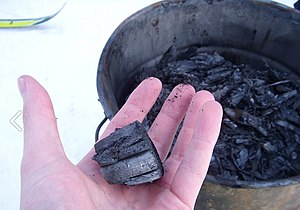生物炭
外观

生物炭(英语:Biochar)有别于一般用于燃料之传统木炭,是一种作为农业土壤改良剂的木炭[1]以及碳收集及储存使用,农业上使用帮助植物生长,但对土壤团粒化没有影响[2]。
跟木炭一样,生物炭是用生物质能原料(例如木材、树叶或枯死的植物),经热裂解之后的产物。其主要的成分是碳分子,因为以无氧或极少氧方式经高温加热产生,在制造过程中,不会像平常燃烧有机物一般,释放出大量的甲烷和二氧化碳。因为对亚马逊黑土的研究,让科学家开始对生物炭发生兴趣。在日本,在农业上使用生物炭也有长久的历史。
近年因为排放二氧化碳、一氧化二氮及甲烷等温室气体造成气候变迁影响,让科学家开始重视生物炭之运用,因为它有助于借由生物炭封存的方式,捕捉与清除大气中的温室气体,将它转化成非常稳定的形式,并储存在土壤中达数千年之久。[3][4][5]
此外,使用生物炭,可以增加20%的农业生产力、净化水质,并有助于减少化学肥料的使用。[4][5]
注释
[编辑]- ^ Read, Peter. This gift of nature is the best way to save us from climate catastrophe. Biochar schemes would remove carbon from the atmosphere and increase food supply, says Peter Read. Guardian (London). 27 March 2009 [2015-11-09]. (原始内容存档于2012-03-26).
- ^ Sarker, T. C.; Incerti, G.; Spaccini, R.; R., Piccolo; Mazzoleni, S.; Bonanomi, G. Linking organic matter chemistry with soil aggregate stability: Insight from 13C NMR spectroscopy.. Soil Biology and Biochemistry. 2018, 117: 175–184 [2019-12-12]. (原始内容存档于2019-12-12).
- ^ Lean, Geoffrey. Ancient skills 'could reverse global warming'. The Independent. 7 December 2008 [1 October 2011]. (原始内容存档于2011年9月13日).
- ^ 4.0 4.1 Geoengineering the climate: science, governance and uncertainty. The Royal Society. 2009 [22 August 2010]. (原始内容存档于2011-09-08).
- ^ 5.0 5.1 Dominic Woolf, James E. Amonette, F. Alayne Street-Perrott, Johannes Lehmann, Stephen Joseph; Amonette; Street-Perrott; Lehmann; Joseph. Sustainable biochar to mitigate global climate change. Nature Communications. August 2010, 1 (5): 1–9. Bibcode:2010NatCo...1E..56W. ISSN 2041-1723. doi:10.1038/ncomms1053.
参见
[编辑]外部链接
[编辑]- (英文)International Biochar Initiative (页面存档备份,存于互联网档案馆)
- (英文)Biochar Fund(使用生物炭来解决粮食安全、森林破坏、地力衰竭、能源匮乏与气候变迁之非营利组织)
- (英文)Biochar Research at Cornell University. [2011-04-17]. (原始内容存档于2020-11-01).
- (英文)Biochar Carbon Sequestration - Home (页面存档备份,存于互联网档案馆)


